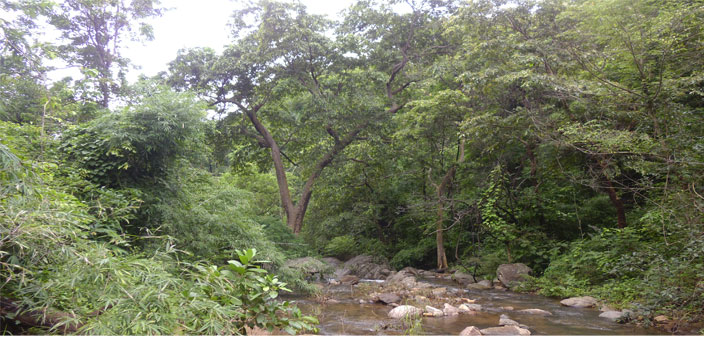Acity is an act of faith. Each one of us living in the city must presume that the police will protect us, that motorists will not intentionally run us over, that the water sources which sustain us will be protected forever.
“A river is unforgiving”, I replied in an interview to the Economic Times after heavy flooding in Mumbai. “You can try to forget it, but one day it will make its presence felt. When urban planners consider rivers, they always tend to plan for its minimum level. But there will always come a time – maybe in four years, maybe in 40 – when today’s calm stream will become a raging torrent.”
All ancient civilisations flourished only when fresh water was available to them. That is why the Nile, Tigris-Euphrates, Indus and the Ganges produced some of the planet’s finest and earliest cultures. Rivers don’t merely supply us with clean water, they also carry away our used water, which is then scrubbed clean by nature so we can use it again and again into perpetuity.
We who live in the city tend to believe that the source of water is a tap. Nothing could be further from the truth. Over 75 per cent of all the water consumed by large cities in India originate either from distant glaciers, or from forests, which sponge the short, sharp monsoon, feed underground reservoirs called aquifers and then… supply it to us all year round.
At one time, concerns such as these used to be written off as ‘alarmist’ and ‘dystopian’. No longer. Climate change is already moving into higher gear. We still have time (just about) to ward off the worst impacts, but if glaciers vanish, wetlands are filled, corals, mangroves and mudflats reclaimed and forests are cut… 1.3 billion Indians will be left with little or no water.
So how should we live with rivers? How did our ancestors live with rivers?
The onset of summer woes
Right now, summer has not even set in and already villages across India are facing water shortages. The level of dam reservoirs is low, largely thanks to bad management, but also because climate change is causing water to evaporate not only from lakes, but also from soils that used to stay moist through the year, until galloping deforestation changed all that.
Climate change. Children know what that could mean to human life because concerned people have been fanning out across the nation to tell them that the vagaries of climate will inevitably lead to water and food shortages. The same message is being sent out to adults who are in the driving seat of national development, but for some reason, the warnings fall on deaf ears. I grew up in Shimla, Hyderabad, Kolkata and Chandigarh. We took clean water for granted, yet respected it because that is what our parents and grandparents taught us to do. But it’s a different world today. I hear people complain about the heat but they do not recognise their own role in the assault on water through the degradation of forests and the pollution of rivers, lakes, and wetlands. Take the case of the Ganga, one of the most revered, yet one of the most polluted rivers in the world. The over-silted Krishna, Godavari and Narmada rivers too are laced with nickle, cadmium and mercury. The Brahmaputra is no longer the annadata it was, but rather, a killing torrent. While Karnataka fights with Tamil Nadu over the Cauveri’s water, the river withers each summer and floods each monsoon because none of those fighting for the water think it worth their while to protect the catchment forests of the Western Ghats, where the mighty river originates.
Even inland lakes such as Chilika in Odisha and Sambhar in Rajasthan have not been spared. These are atrophying in our incapable hands. Assam is fast reaching an environmental point-of-no-return with elephant-occupied wetlands such as Deepor Beel slowly withering. In many rural areas, people (mostly women and children) must walk up hundreds of kilometres each year to obtain water, while increasingly, in urban areas, tankers are the order of the day.
While we talk of India turning into a super-power, I find myself amazed at the fact that planners seem unable to grasp the implication of our per capita water availability having fallen to over half of what it was when India gained its Independence. What is worse, even the precious little we have is being polluted by industry and municipalities. According to experts, the internal security of India in the next decade is more likely to be threatened by water riots and unrest than wars or terrorism. In places like Kutchh, water tables have fallen by hundreds of metres. Coastal aquifers are becoming saline. Streams and rivers are running dry because of deforestation. A vicious corollary of this tragedy is the death of our soils. Long fed on chemical fertilisers and pesticides, vast areas of Punjab, Haryana and western Uttar Pradesh cannot any longer support sustainable yields. To make matters worse, the glaciers that feed north India are melting at an alarming rate.
Glaciers and forests are little other than infrastructures without which our nation’s economy will collapse. Put another way, protecting nature amounts to good long-term economics. This was a fact well known to our elders. But who is to teach such lessons to the planners and politicians who mismanage India today?
It should become the purpose of all development in India to restore health to our ravaged land, to restore quality to the water we drink and productivity to our soils. But I for one do not see this miracle unfold till the consequences of nature force us to take action. With our water and food security on the verge of collapse, we will ultimately be forced to look away from present industrial goals of development. We will be forced to improve generation and transmission capacities of existing power infrastructures, rather than build new projects. We will have to resurface roads, repair culverts and strengthen shoulders rather than build new highways. We will have to re-line canals, improve the condition of catchment areas of existing dams before building new ones.
Our cities are becoming less habitable. In recent times we appear to have lost perspective. Instead of studying the environment around us, we have begun experimenting with our biosphere… with no idea as to the potential consequences.
Can anything be done?
Yes! You can help by making small changes yourself and by refusing to remain a part of the ‘silent majority’, which the late Baba Amte darkly warned would become the ‘silenced majority’ if it did not soon wake up. Here are three small steps that might help restore our cities.
Prevention is better than cure: This should be the policy that governs city management. Prevent water waste (by repairing, maintaining and plugging leaks). Prevent garbage accumulation (by segregating wastes, banning plastic bags, heavily taxing waste generation). Prevent traffic jams (by improving public transport, widening footpaths, creating bicycle lanes and raising parking fees). Prevent ill-health (by reducing or eliminating the generation of toxins in our air, water and food).
The list could go on. Our grandmothers used to give us this sage advice and now scientists and management gurus confirm such wisdom in seminars and workshops around the world. In more ways than one we humans have assumed the mantle of the very gods we love to venerate. In our own image, we have altered everything and in the process we have discovered to our bitter cost that the changes we have inflicted upon ourselves have ended up harming us. When we cut thousands of trees to widen roads, the weather gets worse, there is more dust in the air and therefore in our lungs. More cars at the cost of public transport results in more lead, benzene and sulphur in the air and therefore in our bodies.
That is not all. Because we allow commercial considerations to overwrite environmental and social priorities, land sharks fill our lakes to construct new buildings. Shopping malls selling wastefully packaged goods replace our friendly neighbourhood shopkeepers. Even our hospitals wind up harming us with their careless disposal of biomedical junk. Little wonder we are sicker than our parents used to be, more stressed (noise pollution and traffic), and less secure (women, children and the elderly being victims of enhanced crime).
The city belongs to the children: Who owns the city? Think about it and then consider whether we are treating our cities fairly. Our cities belong to our children. What do you think they will remember us best for? New car parks and shopping malls, or a heritage comprising forested outskirts, tree-lined avenues filled with the calls of barbets, sparkling lakes jumping with fish and a functioning public transport system that kept their air clean? Citizens should call on the principals and teachers of schools and seek their advice on how the city should be run. In fact they should be on the most powerful municipal committees. After all it is these dedicated people in whose charge we have left our children, and there is no one who knows better than them what our children really need.
Swim with nature’s tide, not against it: We don’t really know how the system works, but it does. Everything fits, like a massive jigsaw designed for life. Trees breathe in carbon dioxide and exhale oxygen. The air is breathable, water drinkable and soils productive. The miracle of life so evident around us has justifiably fascinated humans ever since they evolved the capacity to think and abstract.
Work to restore a city’s hydrology (that means restoring its green cover too). Harvest the rain water that is gifted to us by the monsoon. We must also ensure that no more large trees are felled to widen roads, or construct new buildings. In the world’s greatest cities architects now take pride in building around trees, incorporating their canopies into their blueprints. This not only saves trees, but enhances real estate values.


 [/column]
[/column]